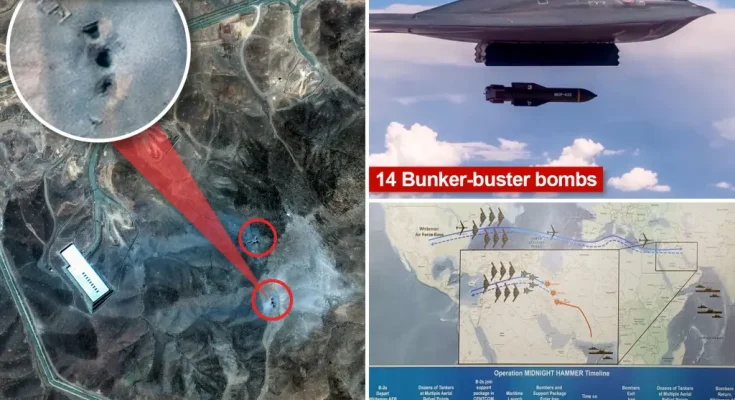
The U.S. military struck three Iranian nuclear sites in the early hours of June 22 local time in Operation Midnight Hammer, intended to shut down Iran’s nuclear program without harming the country’s leadership.
The Trump administration said the damage would substantially delay Iran’s ability to produce a nuclear weapon. But Gen. Dan Caine, Chairman of the Joint Chiefs, said the Pentagon was still awaiting a definitive battle damage assessment.

One key, open question is whether Iran had managed to divert enriched uranium and equipment to safe locations before the U.S. strike, or whether there are other, unknown sites where nuclear work can proceed.
U.S. Air Force bombers and submarine-launched cruise missiles struck the three sites in the early hours of June 22, local time: the Fordow, Natanz, and Isfahan facilities.
At an early morning Pentagon briefing, Defense Secretary Pete Hegseth and Caine offered fresh details on the strikes, revealing that some 125 U.S. planes participated in the mission, 75 precision-guided munitions were expended, and both fourth- and fifth-generation fighters joined B-2 stealth bombers on the mission.

The B-2s dropped 14 Massive Ordinance Penetrators on the Fordow and Natanz sites. It was the first operational use of the GBU-57 MOP, which was designed expressly for this kind of deeply buried targets. Each MOP weighs 30,000 pounds, and each B-2 can carry just two of the weapons, indicating that seven B-2s took part in the operation, an account confirmed by defense officials.
The mission was carefully calculated and its execution included intentional misdirection. Multiple B-2s headed Westfrom Whiteman Air Force Base, Mo., on June 21, with a flight plan that indicated Guam was their destination. The ruse caught the attention of internet spotters and journalists, prompting reports that suggested the aircraft were positioning for a potential future fight. Meanwhile, the strike mission unfolded without notice: Seven B-2s headed east over the Atlantic and Mediterranean Sea before crossing over the Middle East to strike Iran.

The strike package took off from Whiteman—where the entire B-2 fleet is based—just after midnight on the morning of June 21, refueled multiple times en route to Iran with dozens of U.S. tankers, and entered Iranian airspace at 6 p.m. Eastern Time later that day. They returned to the U.S. June 22.

The sites included Fordow, which is buried deep underground, and Natanz, defense officials told Air & Space Forces Magazine. Caine said 30 Tomahawk land-attack cruise missiles were fired from a submarine at the Isfahan site and impacted after the impacts of Massive Ordnance Penetrator bunker buster bombs on two sites.
“Every American involved in this operation performed flawlessly,” Hegseth said.
Caine said the B-2s were led into hostile territory by both fourth- and fifth-generation fighters, most likely F-16s and F-35s. Defense officials declined to identify the specific types or number of fighters, however, but Caine indicated their mission was to protect the bombers on their way into the territory.
territory.
“As the Operation Midnight Hammer strike package entered Iranian airspace, the U.S. employed several deception tactics, including decoys, as the fourth-and fifth-generation aircraft pushed out in front of the strike package at high altitude and high speed, sweeping in front of the package for enemy fighters and surface-to-air missile threats,” Caine said. The Chairman added that the U.S. did not believe Iranian forces—either fighters or air defense forces—fired on the U.S. aircraft.

A defense official told Air & Space Forces Magazine that numerous anti-radiation missiles, including HARMs, were fired by American aircraft to suppress enemy air defenses—the U.S. has Air Force F-16 Wild Weasel fighters and Navy EA-18 electronic attack planes in the region, but whether those aircraft were involved has not been confirmed.
“As the strike package approached Fordow and Natanz, the U.S. protection package employed high-speed suppression weapons to ensure safe passage of the strike package with fighter assets employing preemptive suppressing fires against any potential Iranian surface-to-air threats,” Caine said.
Among the 125 U.S. aircraft involved in the operation were Air Force tankers—the KC-46 Pegasus and KC-135 Stratotankers—at least two kinds of fighters, bombers, and more.
Israel had wiped out most Iranian air defenses in the eight days leading up to the June 21 attack, but without the munitions or bombers capable of destroying a site such as Fordow, Israel had asked for American help. Israel’s punishing air campaign, dubbed Operation Rising Lion, was launched June 12 with the intent of diminishing Iran’s ability to develop and use nuclear weapons. Israel also attacked Iran’s military leadership, killing numerous senior military leaders and systematically undermining Iran’s ability to defend itself.



